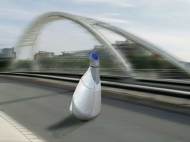Razero ball balancing robot prototype got its new groove
 We already wrote about a robot that balances on a ball named BallIP, and in this article we’re going to write about a robot which uses a similar concept and developed design. Rezero is the name of a robot which is currently developed by a team of thirteen students. The prototype just got a modern design and it is able to balance itself on a sphere both while sedentary and when in motion.
We already wrote about a robot that balances on a ball named BallIP, and in this article we’re going to write about a robot which uses a similar concept and developed design. Rezero is the name of a robot which is currently developed by a team of thirteen students. The prototype just got a modern design and it is able to balance itself on a sphere both while sedentary and when in motion.
The Focus-Project Team Ballbot consists of eight future mechanical engineers, studying at the Swiss Federal Institute of Technology Zurich (ETH Zurich), two electrical engineers from the Zurich University of Applied Sciences (ZHAW) and the Industrial Designers educated at Zurich University of the Arts (ZHdK) which are being supervised by Prof. Dr. Roland Siegwart, Deputy Head of the Insitute of Robotics and Intelligent Systems and Director of the Autonomous Systems Lab at ETH Zurich.
Rezero is the first Ballbot which does not only focus on stability and balancing, but also aims at high agility and higher speed movement. Along with the choice of technically high-class and performance optimized parts, the researchers focus on the drive and the power transmission on the ball, where they try to create as much propulsion as possible with as little weight as possible. Three driven omni-wheels allow a complete control of the sphere with almost no undesired friction.
High-tech sensors and a robust system control form the heart of Rezero’s electronic system. By using a clever combination of several distance sensors and microphones Rezero is able to perceive and to react to its environment and potentially avoid persons or obstacles. However, as seem in the performance display, the team still needs to optimize its movement and adaptation. Its dynamic hull allows Rezero to show and create emotions and its design is the most eye-appealing so far.
As usual, after pointing the good features, it’s time to talk about the drawbacks. The current version of the robot (and even the envisioned improved version) can’t handle steep slopes or stairs. The first problem could be solved with more complex algorithms and advanced sensors and the second requires additional hardware. Another problem with most of the balancing robots is the reaction on the applied force, where its algorithms try to keep it upright without damage to its surroundings. In some events it could fall (due to too much force or in an attempt not to hurt someone or break something) and the developers should add features that could make it upright.
The team envisions its use as a guide, a toy, a service robot or a daily aid, because it can prove its potential in a narrow, varying and crowded environment. They plan to make it able to interact with a small group of people, react on attractions and by doing so create a hands-on experience. Aside the nationally and internationally leading companies who help the project, Rezero is supported by Disney, and they are welcoming new partners.









Razero was recently presented by Péter Fankhauser at TEDGlobal:
http://www.youtube.com/watch?v=ACohrH64YKs